significant growth in the financial year 2021: sales increased to CHF 640.1 million (+20.6% year-on-year, +21.0% in local currencies). Order intake climbed significantly to CHF 788.4 million (+43.9% year-on-year, +44.2% in local currencies). The result is expected to show a substantial increase compared to the previous year. Based on the positive order development in the full year 2021, the Group is cautiously optimistic about the financial year 2022.
Sales in consolidated currency reached CHF 640.1 million (+20.6% year-on-year) and exceeded the previous year by 21.0% in local currency. Compared to the first half of 2021, Interroll was again able to increase its sales momentum. In the second half of the year, a disproportionate growth in the project business in particular contributed to this.
Order intake in 2021 rose to CHF 788.4 million in consolidated currency (+43.9% year-on-year) and grew by +44.2% year-on-year in local currency. The second half of the year saw continued strong business momentum in the markets.
In terms of the result, Interroll expects an increase. According to preliminary figures, the company was also able to increase EBITDA and EBIT. Margins are slightly below the record year 2020 due to increased material prices and the strained supply chains.
“Interroll convinces with its innovative technology platform for material flow solutions. We have significantly expanded our market presence in 2021 and have started the new year with a record order backlog,” explains Ingo Steinkrüger, CEO Interroll Worldwide Group. “We expect positive demand momentum, while at the same time we continue to closely monitor strained supply chains and rising material costs worldwide. Against this backdrop, we remain cautiously optimistic overall, but maintain our cost discipline and continue to do everything we can to further improve our delivery times for customers.”
The complete Interroll Annual Report 2021 with the final audited figures will be presented at the Annual Media Conference on March 18, 2022.





